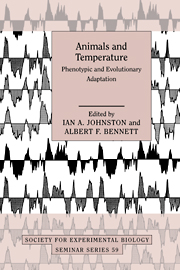Book contents
- Frontmatter
- Contents
- List of contributors
- Preface
- Adaptation of biological membranes to temperature: biophysical perspectives and molecular mechanisms
- Temperature adaptation: molecular aspects
- Stenotherms and eurytherms: mechanisms establishing thermal optima and tolerance ranges
- Ecological and evolutionary physiology of stress proteins and the stress response: the Drosophila melanogaster model
- Temperature adaptation and genetic polymorphism in aquatic animals
- Phenotypic plasticity and evolutionary adaptations of mitochondria to temperature
- Temperature and ontogeny in ectotherms: muscle phenotype in fish
- Ectotherm life-history responses to developmental temperature
- Testing evolutionary hypotheses of acclimation
- Experimental investigations of evolutionary adaptation to temperature
- Thermal evolution of ectotherm body size: why get big in the cold?
- Physiological correlates of daily torpor in hummingbirds
- Development of thermoregulation in birds: physiology, interspecific variation and adaptation to climate
- Evolution of endothermy in mammals, birds and their ancestors
- The influence of climate change on the distribution and evolution of organisms
- Index
Preface
Published online by Cambridge University Press: 04 May 2010
- Frontmatter
- Contents
- List of contributors
- Preface
- Adaptation of biological membranes to temperature: biophysical perspectives and molecular mechanisms
- Temperature adaptation: molecular aspects
- Stenotherms and eurytherms: mechanisms establishing thermal optima and tolerance ranges
- Ecological and evolutionary physiology of stress proteins and the stress response: the Drosophila melanogaster model
- Temperature adaptation and genetic polymorphism in aquatic animals
- Phenotypic plasticity and evolutionary adaptations of mitochondria to temperature
- Temperature and ontogeny in ectotherms: muscle phenotype in fish
- Ectotherm life-history responses to developmental temperature
- Testing evolutionary hypotheses of acclimation
- Experimental investigations of evolutionary adaptation to temperature
- Thermal evolution of ectotherm body size: why get big in the cold?
- Physiological correlates of daily torpor in hummingbirds
- Development of thermoregulation in birds: physiology, interspecific variation and adaptation to climate
- Evolution of endothermy in mammals, birds and their ancestors
- The influence of climate change on the distribution and evolution of organisms
- Index
Summary
Studies of thermoregulation and thermal effects have been one of the most prolific and enduring topics in functional biology for the past century (for reviews, see Hochachka & Somero, 1984; Prosser, 1986; Cossins & Bowler, 1987). The popularity of thermal biology stems from its great significance for biological systems. Temperature has pervasive effects on biological rate processes: rapid changes in body temperature alter nearly all physiological functions by approximately 6–10% per degree Celsius over a broad thermal range. Organismal and population-level traits that depend on those processes, such as energy utilisation, growth and reproduction, are also therefore greatly affected by temperature change. Thus virtually everything that an organism does is influenced by and dependent on its thermal condition.
Despite the major impact of temperature on functional capacities, biological systems have evolved in and adapted to almost every thermal environment on earth. Adult metazoans have successfully colonised environments ranging from –70 °C to 50 °C, while the thermal tolerance of dormant stages and prokaryotes is even greater. Individual organisms and their offspring usually encounter a range of temperatures during their life-cycle, varying from daily cycles to seasonal or longer-term climate change. Responses to a given temperature or temperature change can vary markedly between species and between different life-history stages of the same species. Much of the literature of thermal biology has been concerned with determining thermal tolerances and describing patterns of function at different temperatures.
- Type
- Chapter
- Information
- Animals and TemperaturePhenotypic and Evolutionary Adaptation, pp. xii - xviPublisher: Cambridge University PressPrint publication year: 1996
- 1
- Cited by

